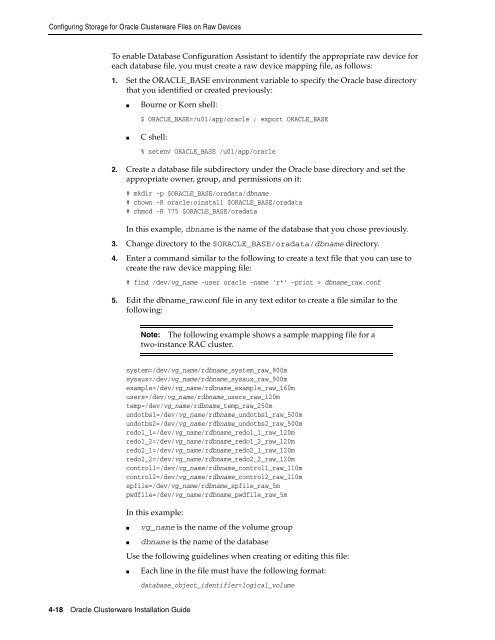Oracle Database Oracle Clusterware Installation Guide for HP-UX
Oracle Database Oracle Clusterware Installation Guide for HP-UX
Oracle Database Oracle Clusterware Installation Guide for HP-UX
Create successful ePaper yourself
Turn your PDF publications into a flip-book with our unique Google optimized e-Paper software.
Configuring Storage <strong>for</strong> <strong>Oracle</strong> <strong>Clusterware</strong> Files on Raw Devices<br />
To enable <strong>Database</strong> Configuration Assistant to identify the appropriate raw device <strong>for</strong><br />
each database file, you must create a raw device mapping file, as follows:<br />
1. Set the ORACLE_BASE environment variable to specify the <strong>Oracle</strong> base directory<br />
that you identified or created previously:<br />
■ Bourne or Korn shell:<br />
4-18 <strong>Oracle</strong> <strong>Clusterware</strong> <strong>Installation</strong> <strong>Guide</strong><br />
$ ORACLE_BASE=/u01/app/oracle ; export ORACLE_BASE<br />
■ C shell:<br />
% setenv ORACLE_BASE /u01/app/oracle<br />
2. Create a database file subdirectory under the <strong>Oracle</strong> base directory and set the<br />
appropriate owner, group, and permissions on it:<br />
# mkdir -p $ORACLE_BASE/oradata/dbname<br />
# chown -R oracle:oinstall $ORACLE_BASE/oradata<br />
# chmod -R 775 $ORACLE_BASE/oradata<br />
In this example, dbname is the name of the database that you chose previously.<br />
3. Change directory to the $ORACLE_BASE/oradata/dbname directory.<br />
4. Enter a command similar to the following to create a text file that you can use to<br />
create the raw device mapping file:<br />
# find /dev/vg_name -user oracle -name ’r*’ -print > dbname_raw.conf<br />
5. Edit the dbname_raw.conf file in any text editor to create a file similar to the<br />
following:<br />
Note: The following example shows a sample mapping file <strong>for</strong> a<br />
two-instance RAC cluster.<br />
system=/dev/vg_name/rdbname_system_raw_800m<br />
sysaux=/dev/vg_name/rdbname_sysaux_raw_900m<br />
example=/dev/vg_name/rdbname_example_raw_160m<br />
users=/dev/vg_name/rdbname_users_raw_120m<br />
temp=/dev/vg_name/rdbname_temp_raw_250m<br />
undotbs1=/dev/vg_name/rdbname_undotbs1_raw_500m<br />
undotbs2=/dev/vg_name/rdbname_undotbs2_raw_500m<br />
redo1_1=/dev/vg_name/rdbname_redo1_1_raw_120m<br />
redo1_2=/dev/vg_name/rdbname_redo1_2_raw_120m<br />
redo2_1=/dev/vg_name/rdbname_redo2_1_raw_120m<br />
redo2_2=/dev/vg_name/rdbname_redo2_2_raw_120m<br />
control1=/dev/vg_name/rdbname_control1_raw_110m<br />
control2=/dev/vg_name/rdbname_control2_raw_110m<br />
spfile=/dev/vg_name/rdbname_spfile_raw_5m<br />
pwdfile=/dev/vg_name/rdbname_pwdfile_raw_5m<br />
In this example:<br />
■ vg_name is the name of the volume group<br />
■ dbname is the name of the database<br />
Use the following guidelines when creating or editing this file:<br />
■ Each line in the file must have the following <strong>for</strong>mat:<br />
database_object_identifier=logical_volume
















